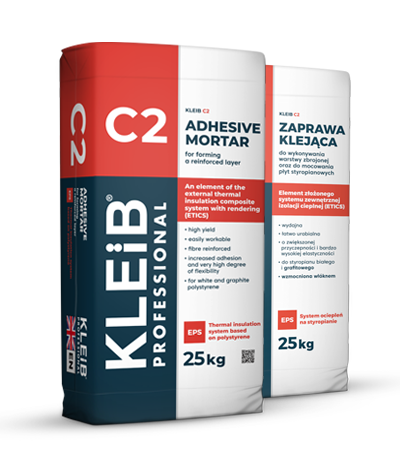ADHESIVE MORTAR
KLEIB C2 is an element of the external thermal insulation composite system with rendering (ETICS) marketed under the trade name KLEIB.
KLEIB C2 is a cement adhesive mortar for forming a reinforced layer in the KLEIB system. It is also suitable for fixing polystyrene sheets on all typical, structurally sound and even mineral substrates (concretes, renders, brickwork, hollow blockwork, stone elements, etc.).
- high yield
- easily workable
- fibre reinforced
- increased adhesion and very high degree of flexibility
- for white and graphite polystyrene

25 kg
54
to form a reinforced layer, approx. 3.0-4.0 kg/m² for panel bonding, approx. 4.0-5.0 kg/m²
CALCULATE CONSUMPTIONKLEIB C2 is a cement adhesive mortar for forming a reinforced layer in the KLEIB system. It is also suitable for fixing polystyrene sheets on all typical, structurally sound and even mineral substrates (concretes, renders, brickwork, hollow blockwork, stone elements, etc.).
Before the formation of a reinforced layer, the surface of the polystyrene sheets should be even, clean, stable and, where sheets were grinded after adhesion, free of dust. In case of using mortar to attach polystyrene sheets, the working surface should be stable, even and structurally sound i.e. strong enough, free from layers that may weaken mortar adhesion, in particular dust, dirt, lime, oil, grease, wax, or residues of oil and emulsion paints. If the surface is too absorbent, it should be cleaned and primed. For this works it is best to apply KLEIB G1 primer.
The mortar is prepared by pouring the entire contents of the bag into a container with a measured amount of water and mixing until a smooth, lump-free uniform consistency is obtained. The mortar is ready to use after 5 minutes and after remixing. Prepare portions that are to be used within approx. 2 hours.
For bonding polystyrene sheets on even surface, it is advisable to apply the mortar on the entire surface of the insulation sheets and spread it with a notched plasterer’s float. In case of an uneven working surface, the mortar should be applied to the sheet in the form of thick layers along its edges, at the distance of approx. 5 cm from the edge, along with 3 to 6 patches of mortar uniformly distributed on the rest of the sheet’s surface. As a result a min. 60% of the surface must be sufficiently adhered to the working surface. Vertical connection of the sheets should be maintained in a staggered arrangement. Further work, i.e. any use of suitable fasteners, grinding of uneven surfaces of sheets, or the application of a reinforced layer can be performed no earlier than after 72 hours. In order to add a reinforced layer on the surface of adhered polystyrene sheets one should apply mortar with the minimum thickness of 3 mm, spread it with a notched plasterer’s float and embed in this a reinforcing mesh of fibreglass. The mesh is best embedded in an arrangement of vertical strips and these to be smoothed so that it is completely invisible and at the same time is not in direct contact with polystyrene sheets. The mesh should be firmly stretched out and completely covered with a layer of mortar with a minimum thickness of 1 mm. Mesh strips should be connected to each other by a min. 10 cm wide overlap. The use of protective nets on scaffolding is recommended. Priming with a suitable primer can begin no earlier than after 72 hours. Tools should be washed with water immediately after use.
Approx. 3.0-4.0 kg/m2 for forming a reinforced layer.
Approx. 4.0-5.0 kg/m2 for attaching sheets
The mortar must be transported and stored in tightly sealed bags, in dry conditions. Protect from dampness. Shelf life in conditions that comply with the specified requirements is 12 months from the production date on the packaging.
